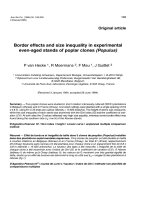garvis - 2009 - does firm size matter in cg - an exploratory examination of bebchuk's entrenchment index [cgs-e-index]
Bạn đang xem bản rút gọn của tài liệu. Xem và tải ngay bản đầy đủ của tài liệu tại đây (297.37 KB, 9 trang )
Competition Forum Vol. 7 (1), 2009
188
Does Firm Size Matter in Corporate Governance? An
Exploratory Examination of Bebchuk’s Entrenchment
Index
Dennis M. Garvis, Washington and Lee University
EXECUTIVE SUMMARY
This study addresses the omission of firm size from discussion in the recent governance literature. Using
the Entrenchment Index developed by Bebchuk, Cohen, and Ferrell (2009) as a measure of governance to
examine samples of U.S. listed companies operating in 2000, 2004, and 2007, I find that there are
significant differences in governance when firms are grouped by total assets and market capitalization.
Furthermore, the results show that the groups of the smallest and largest firms exhibit lower mean
Entrenchment Scores.
Keywords: Corporate governance; Firm size
INTRODUCTION
The influence of corporate governance on corporate behavior has attracted waves of attention from
researchers, investors, and policy makers for more than seventy years (Berle & Means, 1932; Filatotchev &
Boyd, 2009). The continuing importance of governance in publicly held companies is reflected in the
responses of markets, governmental bodies, and media to corporate success, crisis and failure. Corporate
governance research has special relevance to firm competitiveness as companies seek to balance the rights
and responsibilities of parties with a stake in the firm while at the same time competing against marketplace
rivals.
Empirical research of corporate governance has varied widely in discipline, methodology, and
contribution. While research findings have advanced some understanding regarding effective governance,
scholars have recently called for additional work incorporating context into the empirical investigation of
governance (Filatotchev & Boyd, 2009). The present study addresses this issue by investigating the effects
of firm size on corporate governance. Specifically, using Bebchuk’s Entrenchment Index (Bebchuk, Cohen
& Ferrell, 2009) as a measure of governance in U.S. listed companies for samples drawn from 2000, 2004,
and 2007, I find that there are measurable and significant differences in governance based on company size.
Furthermore, I find that the groups of smallest and largest companies showed the lowest levels of
entrenchment in these years.
Examining the effects of firm size in governance is important and timely for academics, policy makers,
and practitioners. This paper contributes to the governance literature by responding to recent calls to
expand governance research into new contexts (Filatotchev & Boyd, 2009) as well as to prior specific calls
for the empirical examination of governance in smaller firms (Huse, 2000; Zahra & Pearce, 1989). The
paper also addresses criticisms of the “one-size-fits-all” implementation of recent governance reforms
(Hertig, 2005).
The remainder of this paper is divided into four sections. First, the issue of governance in the context of
firm size is reviewed by examining both prior conceptual and empirical research from multiple disciplines.
Next, the methodology employed to examine this issue is followed by results. The paper then closes with
discussion of findings.
Competition Forum Vol. 7 (1), 2009
189
DOES FIRM SIZE MATTER IN CORPORATE GOVERNANCE?
Corporate governance has been defined as “[the] structure of rights and responsibilities among the parties
with a stake in the firm” (Filatotchev & Boyd, 2009). Although much previous governance research has
rested on the narrow lens of agency theory to suggest that corporate management must be effectively
monitored so as to guide appropriate corporate behavior, a more recent perspective on governance has
argued that a more holistic and multi-disciplinary approach provides a better account of the complexities of
governance (Filatotchev & Boyd, 2009). The holistic context in which corporate governance operates
necessarily involves both internal and external control over the affairs of the corporation (Walsh & Seward,
1990). The primary internal force exercising control is the board of directors, which by law is granted and
in practice exercises power over corporate management (Walsh & Seward, 1990; Zahra & Pearce, 1989);
additional internal controls are exercised by accounting and finance functions of the firm. In comparison,
external control over the corporation may take many forms. It may be reflected in contests for corporate
control, where outsiders seek to replace top management and directors (Walsh & Seward, 1990; Jensen,
1993). External control may also be imposed by legal and regulatory regimes arising out of statutory and
common law duties and obligations imposed on companies seeking the benefits of local incorporation
(Bebchuk & Cohen, 2003). For example, U.S. companies incorporated in the state of Delaware enjoy the
benefits of a separate corporate judiciary but endure the oversight and costs imposed by legislative and
administrative provisions that establish Delaware corporate requirements. Similarly, companies listed on
the New York Stock Exchange are subject to the scrutiny of the Office of the New York Attorney General,
which has become known for the control imposed by litigation agendas implemented by office holders such
as Rudolph Giuliani, Eliot Spitzer, and Andrew Cuomo. At the national level, companies participating in
U.S. public capital markets are subject to rules adopted by the Securities and Exchange Commission (SEC)
and litigation instituted by both the SEC and the Attorney General of the United States. Companies seeking
the benefits of public capital markets are also constrained by the governance standards included in the
listing requirements imposed by the various stock exchanges (Klein, 2003). External indirect control over
firms also resides with bond holders and bank lenders that are parties to debt contracts that create control
rights that may be enforced if the firm defaults or enters bankruptcy (Shleifer & Vishny, 1997). Indeed, it
has even been suggested that the news media, through its various channels, may indirectly influence
corporate behavior (Dyck & Zingales, 2002; Johnson, Ellstrand, Dalton, & Dalton, 2005).
Other parties have the potential to exert control or influence in the corporation but straddle internal and
external positions. For example, although shareholders with large and concentrated holdings (such as
institutional investors and blockholders) are legal owners of the corporation, they do not have full access to
internal information and are unlikely to be actively and directly involved in monitoring and strategic
decisions (Gillan & Starks, 2003; Cremers & Nair, 2005). Accordingly, despite their position as insider
owners, they may exercise control in only limited circumstances after significant activism efforts or
monetary expenditures to enforce proxy and other rights (Shleifer & Vishny, 1997). Auditors are another
group that straddles inside and outside positions. As outsiders retained by corporation, auditors have
specific external verification and reporting responsibilities in the governance process while at the same
time reporting internally to the audit committee of the board, working with top management, and reviewing
internal information and controls (Klein, 2002).
At first glance, this explanation of governance rights and responsibilities is context free. Boards monitor
and approve management actions, acquirers and investors react, public officials regulate, auditors compile
and report, and the media investigates and informs, all without consideration of setting or situation. In this
view, a factor such as firm size plays no role in the governance of a company. A closer examination
suggests, however, several factors which may explain potential governance differences in small and large
firms. Internally, smaller companies typically do not have the same resources available for the board
functions of the firm (Daily & Dalton, 1993); for example, smaller companies may be less likely to have
access to board capital (Hillman & Dalziel, 2003) and advantageous director networks (Davis, Yoo, &
Baker, 2003). Externally, institutional and large blockholder investors may be less attentive to smaller firms
than larger firms based on the relative scale of holdings in smaller companies. Institutional investors may
be unwilling or unable to devote resources seeking governance improvements in small companies since
these companies may represent only a small portion of their holdings or because management with
Competition Forum Vol. 7 (1), 2009
190
dominant ownership positions in small firms may make investor activism cost prohibitive. Similarly,
attention from regulators as well as the media is typically greater for large firms than small firms.
Regulators must allocate scarce resources amongst various initiatives and political agendas for which small
firm monitoring may not be a high priority. For the media, poor governance in smaller firms is simply not
as newsworthy as that in large, well-known companies.
Differences in smaller companies have also been noted in the practical observations that have been offered
about corporate governance. Thurman (2000) discussed that small companies face far greater challenges in
recruiting directors than large companies. Although having similar needs in terms of director experience
and expertise, smaller companies offer lower reputation and compensation rewards but higher time
commitments and different kinds of risk. Similarly, the Hampel Committee Report (1998) on U.K.
governance practices acknowledged that smaller firms face different constraints in developing boards and
in complying with various regulatory initiatives.
Direct empirical investigation of size differences in governance by academic researchers is relatively rare
(Zahra & Pearce, 1989). In the initial phase of governance code implementation for U.K. public companies,
Cadbury (1995) reported that 90 percent of the largest 100 companies reported full compliance with the
Cadbury Code in contrast to only 26 percent of the smallest companies. Also examining U.K. listed firms
after the introduction of Cadbury practices, Laing and Weir (1999) found that smaller firms were less likely
to have dual CEO/Chairmen and remuneration and audit committees, whereas Conyon and Mallin’s (1997)
review of various U.K. governance compliance reports disclosed noticeable differences in board size and
use of independent non-executive directors. Rediker and Seth (1995) reported differences in the
substitution effects of alternative governance mechanisms (board composition and ownership
concentration) based on firm size from a sample of 81 U.S. bankholding companies. The meta-analysis
performed by Dalton and colleagues (1999) on 131 studies showed that the positive, significant relationship
between board size and financial performance was greater for small firms. Overall, this work suggests that
resource and control factors that influence governance may be different for smaller companies.
A prominent stream of recent research examining the corporate governance-performance relationship
indirectly acknowledges the effects of size. Gompers, Ishi, and Metrick (2003), using a “Governance
Index” of twenty-four variables derived from data collected by the Investor Responsibility Research Center
(IRRC), found shareholder-oriented governance to be positively associated with higher firm value, higher
profits, higher sales growth, lower capital expenditures, and fewer acquisitions. Using a set of variables
from Institutional Shareholder Services (ISS) data, Brown and Caylor (2006) developed a “Gov-Score
Index” of seven characteristics for which they reported significant and positive effects on firm value
measured by industry-adjusted Tobin’s Q. Bebchuk, Cohen and Ferrell (2009), the most recent published
work in this stream of research, has focused on an even smaller set of governance provisions. Bebchuk and
colleagues applied a process (the “BCF Methodology”) to IRRC data that narrowed Gompers’ twenty-four
item Governance Index to six items: staggered boards, limits to shareholder bylaw amendments,
supermajority requirements for mergers, supermajority requirements for charter amendments, poison pills,
and golden parachutes. Noting that these provisions effectively entrench upper management and directors,
Bebchuk and colleagues reported that higher scores in this “Entrenchment Index” were significantly
associated with reductions in firm value and large negative abnormal stock returns.
This recent research has indirectly addressed firm size by treating it as a control variable in the various
methodologies applied by the researchers. Gompers and his colleagues (2003) reported that firm size,
measured by the natural logarithm of market capitalization as well as inclusion in the S&P 500 index, was
significantly and positively associated with their Governance Index in their correlation analysis of U.S.
listed companies over the 1990-1999 time period. Brown and Caylor (2006) reported that firm size,
measured by the natural log of total assets, was significantly and positively associated with Gov-Score in
their Pearson correlation results, and significantly and negatively associated in their regression of Gov-
Score on industry-adjusted Tobin’s Q for their sample of 1,868 U.S. listed companies with both ISS and
financial data in 2002. In their analysis of U.S. listed companies in the time period 1990-2003, Bebchuk
and colleagues (2009) reported statistically significant results for the control variable firm size, measured as
the natural log of total assets, in their full-model pooled OLS regressions of the Entrenchment Index on
Competition Forum Vol. 7 (1), 2009
191
industry-adjusted Tobin’s Q. Indeed, in another instance of indirectly taking firm size into account,
Bebchuk noted that largest firms showed only moderate Entrenchment Scores, reasoning that top
management and directors in these firms were effectively entrenched due to the size of the firm and
therefore did not need protective governance provisions.
In summary, there is both conceptual and empirical research that suggests that the organizational context
arising out of firm size matters in corporate governance. As described in the next section below, Bebchuk’s
Entrenchment Index is used to empirically investigate the potential effects of size in the present study.
MEASURES, SAMPLE, AND METHODOLOGY
Bebchuk’s Entrenchment Index, the measure of corporate governance adopted in this study, is an index in
which firm scores range from 0 (low entrenchment) to 6 (high entrenchment) based on the existence of six
particular corporate charter and bylaw provisions. First developed by Bebchuk and colleagues in 2004 and
subsequently adopted by many governance researchers, it is publicly available via the Web (Bebchuk,
2009). The most recent update to the Index is based on IRRC governance data collected in 1990, 1993,
1995, 1998, 2000, 2002, 2004, 2006, and 2007. In the present study, Entrenchment Indices from 2000,
2004, and 2007 were used to generate yearly samples of companies. The year 2000 was selected since it
presents situational factors arising from the technology and investment booms of the late 20
th
century; 2004
was selected as the first full year that data is available after the enactment of the Sarbanes-Oxley
governance reform provisions in the United States; 2007 was selected as that which has the most current
data available for analysis. Accordingly, selection of these years provides a variety of settings in which
governance decisions were made.
Measurement of firm size is not well-resolved in the governance literature. The corporate governance-
performance research cited above shows size measured by assets, market capitalization, and inclusion in
the S&P index. For Daily and Dalton (1993), small public companies were those firms with less than $20
million annual sales and 500 employees. For Zahra, Neubaum and Huse (2000), medium sized firms were
those with assets between $25 million and $250 million. Rather than attempt to resolve this uncertainty in
the present study, two measures of size were adopted: total assets and market capitalization.
Sample sizes in each of the sample years were ultimately determined by the availability of firm
Entrenchment Scores from Bebchuk’s website and firm financial data from Compustat. Given the
construction of the Entrenchment Index, subject companies were U.S. publicly-listed companies. The
number of companies for which Entrenchment Scores are available is 1669 in 2000, 1759 in 2004, and
1431 in 2007. Available financial data from Compustat reduced the samples in each year, with varying
effects on sample size as reported in the Results.
Descriptive statistics provide basic background analysis for each of the sample years. Simple correlation
analysis was used as the first step in investigating the potential effects of firm size in governance. To
examine potential variation and differences in governance based on size, single-factor analysis of variance
(ANOVA) was used with firm Entrenchment Scores treated as the dependent variable. Levels of the
independent variable, firm size, were created based on dividing the yearly samples into equal parts using
the size measures Total Assets and Market Capitalization. A rough indication of differences resulting from
size can be seen from dividing the firms in the sample years into three groups; finer scrutiny can be
performed with the samples divided into ten groups. Overall, this methodology resulted in four sets of
ANOVA results (firms divided into three groups based on Total Assets; firms divided into three groups
based on Market Capitalization; firms divided into ten groups based on Total Assets; firms divided into ten
groups based on Market Capitalization) for each of the three sample years (2000, 2004, and 2007).
RESULTS
Table 1 reports the full set of descriptive statistics (mean, median, standard deviation, minimum,
maximum) for each of the sample years. There is noticeable variation in firm size in the yearly samples; for
example, mean and median 2000 Total Assets were $14,808.17 million and $1,873.92 million with a
Competition Forum Vol. 7 (1), 2009
192
minimum value of $1.74 million and maximum of $902,210.0 million. Changes between years are also
noticeable, as exemplified by mean Total Assets of $14,808.17 million, $16,437.55 million, and $20,963.15
million in 2000, 2004, and 2007 samples. Another noticeable result in the descriptive analysis is the higher
mean and median Entrenchment Scores reported in the 2007 sample relative to 2000 and 2004 samples.
TABLE 1
DESCRIPTIVE STATISTICS
2000 2004 2007
Total Assets
(in $millions)
Market
Capitalization
(in $millions)
Entrenchment
Score
Total Assets
(in $millions)
Market
Capitalization
(in $millions)
Entrenchment
Score
Total Assets
(in $millions)
Market
Capitalization
(in $millions)
Entrenchment
Score
n
976
957
976
1,317
1,314
1,317
1,403
1,400
1,403
Me
an
14,808.17
10,370.76
2.41
16,437.55
8,401.64
2.55
20,963.15
10,011.16
3.67
Me
dian
1,873.92
1,690.58
2.00
2,082.77
1,955.48
3.00
2,624.16
2,233.77
4.00
s.d.
65,676.93
36,148.80
1.34
86,927.17
26,140.05
1.27
114,357.00
29,189.96
1.25
Min
1.74
0.74
0
1.16
0.82
0
44.31
56.65
0
Max
902,210.00
476,115.54
6.0
1,484,101.00
386,402.07
6
2,187,631.00
504,239.58
6
Pearson correlations for Total Assets, Market Capitalization, and Entrenchment Scores were also run for
each sample year (results available from author). Correlation between Total Assets and Market
Capitalization was positive and significant in all years. Correlation between Entrenchment Scores and both
Total Assets and Market Capitalization was weak but significantly negative in all sample years, indicating
that as company size increased, entrenchment decreased. Accordingly, these results initially indicate that
firm size does have an effect, albeit small, on firm Entrenchment Scores.
The question of whether governance differs based on firm size is addressed by the ANOVA results
reported in Table 2. These results show that when samples are divided into thirds, there are significant
differences in Entrenchment Scores in 2000, 2004, and 2007 except for Total Assets in 2000. When the
samples were divided into ten groups, there were significant differences in every ANOVA test for every
sample year. In summary, all but one of the twelve ANOVA results are statistically significant.
TABLE 2 ANOVA
Yearly Samples Divided into
Three Groups based on: Total Assets Market Capitalization
F value sig. F value sig.
2000 0.776 0.461 6.286 0.002
2004 4.568 0.011 3.118 0.045
2007 5.148 0.006 5.238 0.005
Yearly Samples Divided into
Ten Groups based on: Total Assets Market Capitalization
F value sig. F value sig.
2000 3.329 0.001 3.531 0.000
2004 3.945 0.000 4.520 0.000
2007 5.373 0.000 3.525 0.000
In addition, the pattern of these results in terms of mean Entrenchment Scores for the firm groupings are
noticeable, as reflected in Figures 1 through 4. In Figures 1 and 3, Group 1 represents the smallest firms,
progressing to Group 3, representing the largest firms. In Figures 2 and 4, Group 1 represents the smallest
firms, progressing to the largest firms in Group 10. These graphs plot group mean Entrenchment Scores for
the various categories of firm size. When divided into thirds, the mean Entrenchment Scores of firms in the
smallest and largest size groups were lower than those in the middle third. This is true regardless of the
Competition Forum Vol. 7 (1), 2009
193
sample year (2000, 2004, or 2007) or the method of measuring size (Total Assets or Market Capitalization).
When divided into tenths, similar patterns are evident, in that the mean Entrenchment Scores for the
smallest and largest groups of firms are lower. Overall, there is empirical support that suggests that firm
Entrenchment Scores significantly differ based on firm size.
ANOVA RESULTS, GROUP MEANS FOR SAMPLES DIVIDED
INTO THIRDS BASED ON TOTAL ASSETS
ANOVA RESULTS, GROUP MEANS FOR SAMPLES DIVIDED
INTO TENTHS BASED ON TOTAL ASSETS
ANOVA RESULTS, GROUP MEANS FOR SAMPLES DIVIDED
INTO THIRDS BASED ON MARKET CAPITALIZATION
ANOVA RESULTS, GROUP MEANS FOR SAMPLES DIVIDED
INTO TENTHS BASED ON MARKET CAPITALIZATION
DISCUSSION
The vital role that corporate governance plays in our current business environment has been emphasized by
academics, policy makers, and practitioners from many countries. The present study set out to explore the
effects of firm size on corporate governance, an issue which had been indirectly addressed by many
researchers but rarely directly empirically investigated. The results show first a significant but weak
negative relationship between governance, measured by Bebchuk’s Entrenchment Index, and both
measures of firm size, Total Assets and Market Capitalization. More importantly, based on results from
ANOVA testing, there are significant differences in governance when firms are grouped by size, with
groups of smaller and larger firms showing lower mean Entrenchment Scores than medium sized firms.
This is true for all sample years and for all measures of firm size, providing consistent evidence of the
effects of size in three different economic environments of the years 2000, 2004, and 2007. Accordingly,
these findings offer empirical evidence that firm size serves as an important contextual factor in corporate
governance.
Focusing narrowly on entrenchment, the findings indicate that differing contexts such as size may lead to
differing governance characteristics for firms. This result raises potential new questions for entrenchment
related research. For example, what combination of factors influences the behavior of executives and
managers in medium firms to entrench themselves at higher levels than that in both smaller and larger
firms? What is unique about the context in which these firms operate that leads to higher entrenchment?
Another question could be pursued with methodologies that take size into account. For example, the BCF
Competition Forum Vol. 7 (1), 2009
194
methodology that determined the six governance provisions relevant to performance was applied without
regard to size. If the BCF or a similar methodology were applied to firms grouped by size, would different
provisions be relevant to entrenchment? In other words, would the combination of IRRC provisions that
matter in the entrenchment of executives and directors in the largest firms differ from the combination of
entrenchment factors relevant to the smallest firms?
There are other new directions for governance researchers suggested by the results of this study. First, an
extension investigating the effects of size could examine groupings based on that which occurs when firms
are assigned to the large-capitalization, mid-capitalization, and small-capitalization investment indices (i.e.,
S&P 500, S&P Mid-Cap 400, and S&P Small-Cap 600). Second, recent research showing relationships
between corporate governance indices and corporate performance can be extended. Since the current paper
suggests that governance differs by firm size, one potential new direction would be to explore whether the
governance-performance relationship also varies by size. Finally, since the results in this paper hint that the
relationship between governance and size may not be linear, additional research could examine the
possibility that the governance-performance relationship is not linear.
Overall, the results highlight the view that corporate governance is an integrated system in which internal
and external factors operate differently in different contexts. Accordingly, an important step has been taken
in corporate governance research to uncover the diversity of arrangements and to understand whether
differences exist in corporate governance practices. Indeed, one size does not fit all.
REFERENCES
Bebchuk, L. A. & Cohen, A. (2003). Firm decisions where to incorporate. The Journal of Law and
Economics, 46, 383–425.
Bebchuk, L. A (2009). Data on the entrenchment index, retrieved June 26, 2009 from
faculty/bebchuk/data.shtml .
Bebchuk, L. A., Cohen, A., & Ferrell, A. (2009). What matters in corporate governance? Review of
Financial Studies, 22(2), 783-827.
Berle, A., & Means, G. (1932). The modern corporation and private property. New York: Macmillan.
Brown, L. D. and Caylor, M. L. (2006). Corporate governance and firm valuation. Journal of Accounting
and Public Policy, 25(4),409–34.
Cadbury, A. (2002). Corporate governance and chairmanship: A personal view. Oxford: Oxford
University Press.
Cadbury, A. (1995). Committee on the financial aspects of corporate governance: Compliance with the
code of best practices. London: Gee Publishing.
Conyon, M.J. & Mallin, C.A. (1997). A review of compliance with Cadbury. Journal of General
Management, 2(3), 24-37.
Cremers, K.J.M. & Nair, V.B. (2005). Corporate governance and equity prices. The Journal of Finance,
60(6), 2859-2894.
Daily, C.M. & Dalton, D.R. (1993). Board of directors leadership and structure: Control and performance
implications. Entrepreneurship Theory & Practice, 17, 65-81.
Dalton, D.R, Daily, C.M., Johnson, J., & Ellstrand A. (1999). Number of directors and financial
performance: A meta-analysis. Academy of Management Journal, 42, 674- 686.
Davis, G.F., Yoo, M., & Baker, W.E. (2003). The small work of the American corporate elite. 1982-2001,
Strategic Organization, 1(3), 301-326.
Dyck, A. & Zingales, L. (2002). The corporate governance role of the media. CRSP Working Paper No.
543, retrieved June, 2006 from
Filatotchev, I. & Boyd, B.K. (2009). Taking stock of corporate governance research while looking to the
future, Corporate Governance: An International Review, 17(3), 257-265.
Gillan, S.L. & Starks, L.T. (2003). Corporate governance, corporate ownership, and the role of institutional
investors: A global perspective. Journal of Applied Finance, 13(2), 4-22.
Gompers, P.A., Ishii, J.L., & Metrick, A. (2003). Corporate governance and equity prices. Quarterly
Journal of Economics, 118(1), 107-155.
Competition Forum Vol. 7 (1), 2009
195
Hampel, R. (1998). The final report of the committee on corporate governance. London: Gee Publishing.
Hertig, G. (2005). On-going board reforms: One size fits all and regulatory capture. Oxford Review of
Economic Policy, 21(2), 269-282.
Hillman, A. & Dalziel, T. (2003). Boards of directors and firm performance: Integrating agency and
resource dependence perspectives. Academy of Management Review, 28, 383-396.
Huse, M. 2000. Boards of directors in SMEs; A review and research agenda, Entrepreneurship & Regional
Development, 12: 271-290.
Jensen, M. (1993). The modern industrial revolution, exit and the failure of internal control systems.
Journal of Finance, 48, 831-880.
Johnson, J.L., Ellstrand, A.E., Dalton, D.R., & Dalton, C.M. (2005). The influence of the financial press on
stockholder wealth: The case of corporate governance. Strategic Management Journal, 26(5), 461-472.
Klein, A. (2002). Audit committee, board of director characteristics, and earnings management. Journal of
Accounting and Economics, 33(3), 375-400.
Klein, A. (2003). Likely effects of stock exchange governance proposals and Sarbanes-Oxley on corporate
boards and financial reporting. Accounting Horizons, 17(4), 343-355.
Laing, D. & Weir, C.M. (1999). Governance structures, size, and corporate performance in UK firms.
Management Decision, 37(5), 457-464.
Rediker, K., & Seth, A. (1995). Boards of directors and substitution effects of alternative governance
mechanisms. Strategic Management Journal, 16, 85-99.
Schleifer, A. & Vishny, R.W. (1997). A survey of corporate governance. Journal of Finance, 52, 737-783.
Thurman, R. (2000). The unique nature of small-company boards. Directors & Boards, 24(4), 31-36.
Walsh, J.P & Seward, J.K. (1990). On the efficiency of internal and external control mechanisms. Academy
of Management Review, 15(3), 421-458.
Zahra, S., & Pearce, J. (1989). Boards of directors and corporate financial performance: A review and
integrative model. Journal of Management, 15, 291-244.
Zahra, S., Neubaum, D., & Huse, M. (2000). Entrepreneurship in medium-sized companies: Exploring the
effects of ownership and governance systems. Journal of Management, 26(5), 947-976.
Reproduced with permission of the copyright owner. Further reproduction prohibited without permission.









